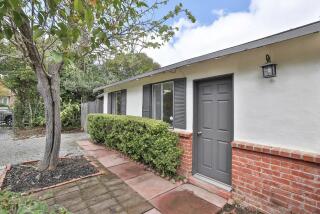San Francisco considers allowing nation’s tiniest micro-apartments
SAN FRANCISCO — The tiny apartments are touted as “affordable by design.”
New York City has launched a pilot project to test them out. Boston is doing it too. But here in San Francisco, where a growing number of residents are being priced out of the housing market by a revived tech economy, city leaders are considering the smallest micro-units of all.
At a minimum 150 square feet of living space — 220 when you add the bathroom, kitchen and closet — the proposed residences are being hailed as a pivotal option for singles. Opponents fear that a wave of “shoe box homes” would further marginalize families of modest means who are desperate for larger accommodations.
FOR THE RECORD:
San Francisco housing: In a Sept. 24 LATExtra story about San Francisco micro-apartments, a statement attributed to Supervisor Scott Wiener said that he expected rents on the proposed 220-square-foot units to range from $1,200 to $1,700. Wiener expects them to range from $1,200 to $1,500. In addition, the article misidentified the organization of which Sara Shortt is executive director. It is the Housing Rights Committee of San Francisco, not the Human Rights Committee of San Francisco. —
On Tuesday, the Board of Supervisors will consider tweaking the city’s building code, which requires newly constructed units to be at least 290 square feet.
The number of micro-units that could be built under the proposal would not be capped, although critics are pushing for controls on the experiment. New York Mayor Michael R. Bloomberg, for instance, has signed off on just 60 apartments that would be 275 to 300 square feet small.
Patrick Kennedy — a Berkeley-based developer who in November will unveil a building with 300-square-foot units in San Francisco’s South of Market neighborhood — has said he hopes to build several thousand even smaller models.
The mini-apartments’ schematics include window seats that convert to spare beds and beds that transform into tables. Bay windows offer sweeping views.
“You could obviously build more of them if you don’t have to do them as large,” said Kennedy, adding that pricing would be determined after he sees “what the market does with our 300-footers.”
Supervisor Scott Wiener, who drafted the legislation, said smaller units will mean cheaper and more plentiful housing options. With a tech boom underway, thousands of new hires have been snapping up San Francisco’s rental stock.
The micro-units will probably go for $1,200 to $1,700 a month, Wiener said. According to the real estate service RealFacts, an average studio apartment in San Francisco now goes for $2,075.
So in a metropolis where 41% of residents live solo, Wiener said, the units would fill a niche by allowing people to stay who might otherwise have to take on roommates or leave town.
“Although in our fantasy world everyone would live in a single-family home or a huge spacious flat, the reality of life is that not everyone can afford that,” he said, noting the micro-units with shared common space would be ideal for students, artists and seniors.
But some critics worry that the swank model units getting kudos from officials might not be the norm. What’s to stop other developers, tenants’ rights advocates ask, from building grimmer versions, with low ceilings and poor light?
“I say no shoe box legislation,” Carmelita Perez, 67, told demonstrators at a recent news conference, where a small child sat inside a mock unit taped to the sidewalk in front of City Hall. “We are humans, not spiders.”
Supervisor Jane Kim, whose district includes South of Market, said she feared the push for ever-smaller apartments would do nothing to benefit families that already are being driven out of town.
The price per square foot of Kennedy’s proposal, she and other skeptics said, was less affordable than current rentals. And buildings full of micro-units could cause a spike in population density that might strain public transit and already limited parks and public spaces.
In Singapore, where thousands of shoe box homes for families — some as small as 500 square feet — are either completed or in the pipeline, redevelopment authorities recently raised the minimum size to 755 square feet because of congestion. The revised approach is fodder for doubters here.
“This has to be a pilot project and allow for further study before we end up like Singapore,” said Sara Shortt, executive director of the Human Rights Committee of San Francisco, a tenants’ rights group that is part of a coalition negotiating with Wiener.
Not all affordable-housing advocates, however, are against the proposal.
Sherilyn Adams, executive director of Larkin Street Youth Services, said she viewed the proposed micro-units as an opportunity “for people who would have been otherwise pushed out of the market” — although she would like to see housing with support services for those with low incomes.
Among those who already spend their days and nights in tiny spaces, there is disagreement on the merits.
Cubix Yerba Buena — a South of Market condo complex of studio units with around 300 square feet — went on the market during the recession.
One Yelp reviewer dissed the condos as “no bigger than most hotel rooms” and only three times larger than “the average U.S. prison cell.”
But another buyer was effusive: “If it wasn’t for Cubix SF I would have never been able to afford to buy anything in the whole Bay Area by myself,” a woman named Jazz wrote. “I’m moving from a 450 sq feet rental into 280-sq-feet of all mine & feel like I’m the luckiest so in so on the planet. ….Thank you Universe!”







